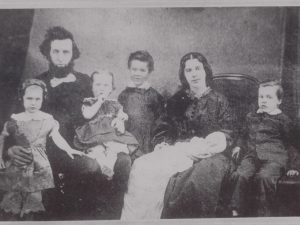Have you ever lost it—at a time when things were humming along for you?
You were feeling good—until someone said or did just the thing to set you off. You got derailed, pushed out of your sweet spot. You stopped listening and started reacting. You no longer felt like a competent, functioning adult, responsible and caring. You turned into that awkward adolescent all over again as fears and big feelings took over.
Of course you have! We all lose it, some of us more than others. No matter how good our intentions, or how strong our willpower, we are no match for unregulated feelings. We all reach a tipping point. Our ability to manage what we feel sets the limits on our enjoyment of life and relationships. Under the right conditions, all of us can be pushed too far. But the trick is knowing how to get back to that sweet spot, those healthy emotions. When we don’t know how to get back, life becomes unbearable.
We all have “buttons”—people or issues that send us spiraling. We reach the point where we feel fragile. Before we know it, we say and do things we wish we could take back. We lose our temper. Some of us slip into depression. Others become anxious. All these have one thing in common: Someone or something has stolen our joy. If you can relate to any of these feelings, congratulations! You are human. You no longer have to stay stuck in the prison of painful emotions and hurtful reactions. You don’t have to stay lost during difficult relationships. You can train your brain to bring joy back. With practice, you can help your brain hold onto joy longer. You can make joy your new normal.
The secret circuit
Brain science says you are the possessor of a great gift. This is no ordinary gift. The gift makes people glad you are here. When used, this gift brings smiles, laughter, even warm, fuzzy feelings. This gift is not money, fame, power or good looks.
Inside your brain is a secret circuit, a relational engine. I refer to this engine as your brain’s secret circuit because it’s there, but people do not know how to use it. This secret circuit is your brain’s relational circuit, which oversees your ability to engage the world—even God. How well this relational circuit is working will have a profound effect on your life. Each of us feels its presence or absence every waking moment.
There is only one problem. This relational circuit can easily turn off. When we do not know how to correct this, we are in trouble. Once this brain circuit goes off, we want to find a way to switch it back on. Otherwise, we relationally flounder. This brings us to the Joy Switch.
The Joy Switch
The Joy Switch is the lever we must pull, the button we must press, to restore the best of our personality, character and identity. Here is our ability for joy. The Joy Switch turns on the relational circuit—which changes everything. How well we use the Joy Switch determines if we reach our full relational potential. This ability is within our reach.
Learning to use the Joy Switch restores the relational circuit so we stay a living reflection of the person we want to be. Otherwise, we relationally explode or we implode. We lose it with family, friends, coworkers, other drivers, neighbors and more. We “let them have it” or we may beat ourselves up in a sad sort of way. The good news is, the Joy Switch is accessible so you can start some joy. All it takes is a little direction.
We learn to use the Joy Switch by using what I call CARS to reach our relational destination. CARS stands for Connection, Appreciation, Rest and Shalom my Body. (Watch me demonstrate Shalom my Body exercises.) Each of these four options shifts us from shutdown mode to full relational engagement where our brain’s relational engine is running again. We connect with people who help us feel seen and heard, we remember the good stuff which makes us smile, we pause to catch our breath and we practice specific exercises to help our body relax. Each of these Joy Switch options can move us to relational mode so we stay relational.
Expecting joy
The relational circuit is supposed to come on when we expect joy. Joy is the fuel to run the brain’s relational engine. Joy is glad-to-be-togetherness, where we light up to see others and they light up to see us. We are the sparkle in someone’s eyes. The nonverbal dance of eye smiles makes us feel seen and special. This exchange is more of a reflex than a choice or decision of the will
Once we have enough face-to-face joy, we are ready for a pause, the breather that allows rest so we can build more joy. A rhythm develops. We alternate high-energy joy with low-energy rest as two brain states. In this case, being “low energy” is a good thing. But if every time you see your best friend they seem angry, your relational circuit will stay off because there is no joy. We can say the relational circuit gives us relational superpowers. We learn to use the Joy Switch to activate relational abilities that turn us into superheroes. Learning to stay relational and maximize joy gives us the bandwidth to stay present and suffer well when things go wrong. We will find no shortage of opportunities to practice using the Joy Switch.
Excerpted from The Joy Switch: How Your Brain’s Secret Circuit Affects Your Relationships – And How You Can Activate It by Chris M. Coursey (©2021). Published by Northfield Publishing. Used with permission.
Do Good:
- Read The Joy Switch: How Your Brain’s Secret Circuit Affects Your Relationships – And How You Can Activate It (Northfield Publishing, 2021) by Chris M. Coursey.
- See more about joy in Life Model materials including E. James Wilder, Ed Khouri, Chris. M. Coursey, Shelia D. Sutton, Joy Starts Here: The Transformation Zone (East Peoria, IL: Shepherd’s House, Inc., 2013).
- Experts urge us to find calm by looking inward and muting the outside world, but what if we can access joy in the world around us? As designer, TED speaker and author Ingrid Fetell Lee of the Aesthetics of Joy shares on this episode of the Do Gooders Podcast, research shows a clear link between our surroundings and our mental health.













